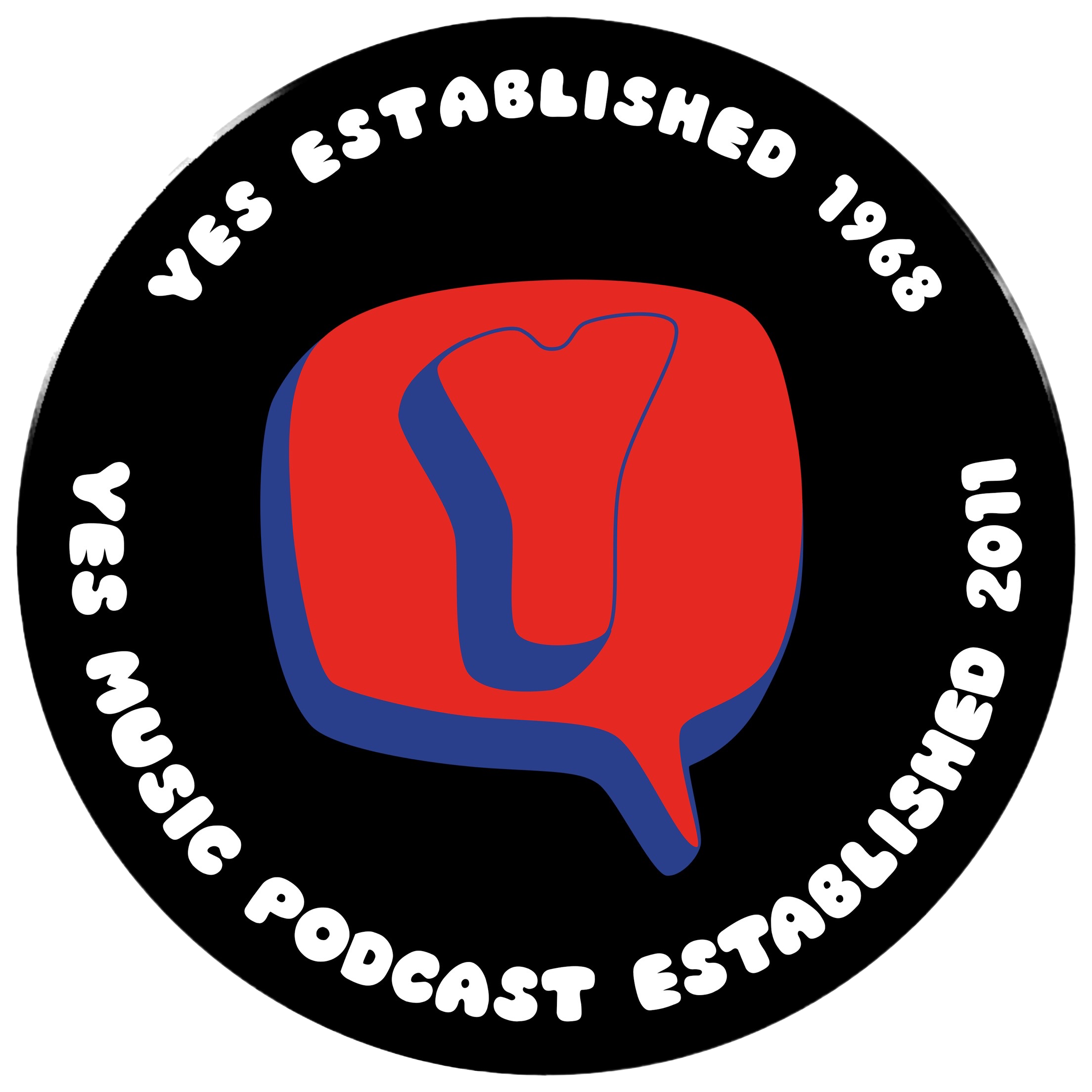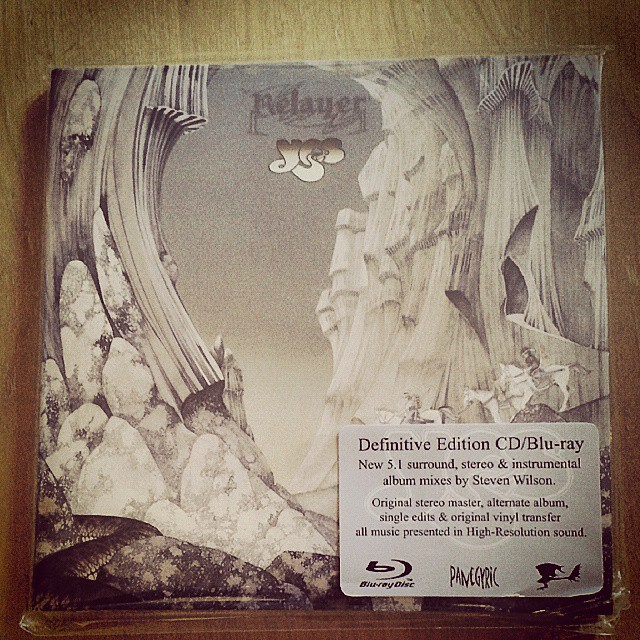Podcast: Play in new window | Download
Subscribe: Apple Podcasts | Spotify | RSS
 Produced by Preston Frazier, Bill Govier, Wayne Hall and Michel Arsenault.
Produced by Preston Frazier, Bill Govier, Wayne Hall and Michel Arsenault.
After the excitement of episode 300, we are back with some more great Yes discussion – this time about the album covers we think are the most and least effective. There’s also time for a 2 pence about ARW and their covers…
- Which is the most effective Yes album cover?
- Which is the least effective?
- Is it all about Roger Dean?
Listen to the episode then let us know what you think!
Become a YMP Patron!
If you would like to support the Yes Music Podcast, there is a Patreon page where you can sign up.
The iOS YMP app! Download it here.
The Android YMP app! Download it here.
Craig Tiren spotted this:
Glen Alexson spotted Art Griffin’s Sound Chaser – https://artgriffinsoundchaserblog.wordpress.com/
Show notes and links
Get your Yes 50th Anniversary free pass here
Join the 50th Anniversary Facebook group here
 YMP patrons:
YMP patrons:
Preston Frazier | Bill Govier | Wayne Hall | Michel Arsenault
…
Joseph Cottrell | Jeffrey Crecelius | Michael O’Connor | Paul Tomei | Geoffrey Mason | Lobate Scarp | Fergus Cubbage | Robert Nasir | Steve Dill
…
Paul Wilson | Jamie McQuinn | Miguel Falcão | Ken Fuller | David Pannell | Brian Sullivan | Joost Doesburg | Jeremy North | Tim Stannard | David Watkinson | Steve Roehr | Geoff Baillie | William Hayes
…
Robert
Please subscribe!
If you are still listening to the podcast on the website, please consider subscribing so you don’t risk missing anything. You can subscribe with an RSS reader, with iTunes, with the iOS Podcasts app, via email updates, via www.stitcher.com on Spreaker.com or via Tunein.com.


18 replies on “Yes Album Covers – The Good The Bad And The Ugly – 301”
Great episode about the sleeve art. Although I remain agnostic about the awesomeness of ‘Topographic Oceans’, Roger Dean’s cover simply has to be the definitive Yes artwork – the sheer excessive deliriousness of it matches Yes’s music at its most expansive.
Worst has simply got to be Open Your Eyes, which is just the bubble logo on black, with functional typography in the sleeve notes and no photography or interior artwork at all. MAK compares it to the first album to suggest that they were aiming for a ‘new era’ type effect – but to me it comes across as just the cheapest, most expedient option and makes it come across like one of those cheap compilations you find at highway gas stations. At the time, it suggested that Yes had fallen to where they were now on a no-name label that couldn’t afford any art/photography – and that maybe the band couldn’t be bothered getting together for a group photo. I think it gave the impression that Yes were in the ‘playing the state fair’ twilight of their career (while actually listening to the album suggested their artistic direction, ahem, wasn’t its strongest).
I’m perfectly fine with the Going For The One album cover. I discovered Yes in the late 80s, and I was only vaguely aware of the chronology of the albums, and didn’t take any notice of there being a different cover artist. I didn’t listen to this album until c.1992, by which time I’d seen the “Owner Of A Lonely Heart” video many times, and the connection seemed obvious to me. The actors all keep their pants on in the video, but you have to admit that the video’s urban setting, scenes of a man’s and images of a lone man in bed or in the shower recalls the skyscrapers and (and the butt) of the album cover. The interpretation I always gave it – the naked man in his ‘natural’, Edenic state confronted by the urban landscape of skyscrapers with no other humans in sight (suggesting a lack of “humanity” in modern life; or something….) – is at least thematically grand enough for a Yes epic. I agree it’s probably more suited to a more ‘techincal’ band than Yes (it reminds me of something by the Alan Parsons Project or someone like that), but I made a thematic connection there, and the different cover artist didn’t jump out at me (especially since the bubble logo is still there). It’s certainly in keeping with the elaborate sleeve art of all the major rock bands of the period.
I think the GFTO cover might be better suited to use for Drama. Like I mentioned earlier, using Roger Dean again might have been to reassure fans that this was “really Yes” despite the line-up change, but I find that I didn’t hear the whole Drama album until 2011 (if you can believe that), and when I first heard “Machine Messiah”, it put me in mind of a classic Marvel Jack Kirby comic, when they were all about the births and arrivals of giant cosmic beings and such. While using the Dean cover was probably the right move career-wise, I feel that the fantastic landscapes clash a bit with the technology themed lyrics (cars, cameras, machines, even possibly time travel….. ‘time flies’ and all that).
Ugh…. I really should’ve proof read that before posting……..
Definitely cannot agree with GFTO not matching the music.
Yes’s reunion with Rick Wakemen produced an album that has a couple of epics (Turn of the Century and Awaken, both true classic yes numbers) and two rockers (Parallels and the title track) as well as a poppy number. The epics are nothing like those on the previous three albums and nothing like the rockers had appeared since Roundabout and Yours is No Disgrace (yes, there had been rocky sections but these were always part of an epic). Wondrous Stories harks back to the second album.
So, my take is that GFTO is a natural progression from TYA/Fragile. In the same way those albums also spawned CTTE which spawned TFTO and Relayer in different branches. The “tree” of musical ideas within Yes is at least as complex as the musical family tree. Like the journey from common ancestor to homo sapien – this is only one of several branches.
So – it is appropriate that the cover is different to those that preceded it. (In the same way that most seem to agree that the 90125 cover is different to previous covers)
On to the cover itself. I have always had a similar feeling about the cover as Charles Christopher, above and he puts it very succincly when he describes “the naked man in his ‘natural’, Edenic state confronted by the urban landscape of skyscrapers with no other humans in sight (suggesting a lack of “humanity” in modern life; or something….) “. I see it as stripped down man questioning the race to the top – the skyscrapers which dwarf the character representing big business – the epitome of success in the Western Word (although this predates Thatcherite Britain by a couple of years – how prescient!)
Rush’s “Hemispheres” cover mentioned by MAK has the same cover concept (if my interpretation is correct)- with success being represented by a businessman instead of skyscrapers.
more later ….
… later!
In general terms I feel the cover for GFTO has a lot to do with the music. The angular shape of the skyscraper images and the graph lines (on the front cover at least) seem to echo the harshness and angular shape of the lap steel in the title track. The skyscrapers themselves are no less than the “workings of man” and presented as they are looking down upon the naked male Masters of this, that and the other. Yes, I’m stretching a point, but it has always had that feeling for me.
The cover also illustrates one interpretation of the title track itself. Discussions on songmeanings.com suggest one interpretation is the futility of sport – I’ve always seen that as wider than just sport, rather going for success in any area – or in this case the Western world. The naked man is comparatively weak but determined, yet at the same time seems to question the wisdom of doing so.
So, in summary, I think it’s a great cover – representing a different branch on the Yes musical tree, and illustrating the more modern style of some of the tracks and the themes of others.
.
.
.
But who knows ….?
Oh… by the way, the cover which best represents the music within for Yes and related music -Olias of Sunhillow. Upon seeing the cover I somehow knew all the music within which I was yet to hear. Remarkable,
Worst – I’mm with MAK, 1984 by Rick. Not a masterpiece nor a total disaster as an album, but the cover had little to do with the contents.
Indeed on both choices of covers.
Sunhillow had an amazing package. It might actually be even better than the music. We shouldn’t forget Beginnings either. A fantastic piece of artwork even if the singing rather takes the gloss off the imagery and what is some fine writing and playing. Dean was on a roll in that period. Relayer we’ve talked about and Yesterdays is an absolutely fantastic piece of work too despite having some elements that probably wouldn’t get cleared for release by a record company in 2017.
Great podcast and discussion. Regarding the GFTO cover…I was 19 when that came out in 1977. I’d already been a Yes fan since Fragile. It was clear to me that Yes was making a statement. In 1973, Yes was new and edgy. By 1977 -though it may be hard to believe- Yes was already seen as somewhat of a dinosaur. Bands like Yes and Led Zeppelin were being pushed aside by the New Wave and Punk bands (although the full force of that was a few years off). I think Yes was trying to reset their image away from the fantasy, hippy-trippy image that a lot of people had of them. The same for the song GFTO; it was a straight ahead (well, for Yes, anyway) rock and roller. Yes were saying “see we can play straight ahead rockers too.” Incidentally, I think the buildings in the cover photo are a collage of the office buildings in Century City, CA, near Beverly Hills. My and my buddies used that location as a photo backdrop more than once. Those buildings were considered very new and modern at the time.
Also, look at the Wikipedia entry for the GFTO album. There is a brief explanation of why a Dean cover wasn’t chosen; doesn’t really deny or support my impression, but there it is.
As far as best covers that describe the music therein, I agree with both Mark and Kevin: TFTO and Relayer.
Part 2. I forgot to mention. GFTO again: the choice of the naked man was also, I believe a sign of the times. As you may remember, a lot of late 60s and early 70s album covers featured naked women. Sex sells. So, it was an easy eye-catcher to put a naked woman on the cover. By 1977, this seemed pretty sexist. I believe Yes (or at least the cover designer, Storm Thorgerson) were trying to be more egalitarian and progressive-minded by using a naked man. Same with Rush. You be the judge.
Well a lot of rock LPs back in the early 70s had pictures of naked children. Including one from our heroes in Yes. Go figure that one out.
Wow – a lot of commentary on GFTO! Not my favorite Yes album but probably their best work. I never really thought much about how the art work relates to the music, but after Relayer and seemingly endless touring, it does seem to announce in a rather dramatic fashion “HEY – here’s something really stunning!” The lines of the building(s) draw your eye up toward the Yes logo as if to confirm that, Yes, this really is THAT band, despite the type of art you’ve come to expect.
As for Relayer itself, I’ve always thought that the cover seems like a visual representation of of not just the music, but the way it sounds, the way it was recorded and produced – despite the intense complexity of the compositions, there’s something like a dry, papery FEEL to the album. t’s just the perfect blend of visual and audio.
Worst cover of all time (and maybe not just for this particular band) goes to an album I always refer to as “Cover Your Ears.” I agree with Charles C. – it looks like something you would find in the cut-outs bin at Walmart, or the CD selection of retread “best of” compilations available at your local truck stop… which sort of makes it the perfect cover art for this album. You can Open Your Eyes if you want, but there’s nothing to see… and not much worth listening to, either.
The brief discussion of just how closely Yes is identified with that one particular logo – with a few detours along the way – made me think of another, different band; hugely successful, with a boat load of studio and live albums, that went out of their way to NEVER be tied to a particular logo: if you don’t mind us returning to the “Rush Music Podcast” briefly… I can’t help but wonder what a Roger Dean Rush album cover might have looked like…
Great show, as always, gentlemen – and a particularly intriguing subject this week. Thanks!
I remember buying GFTO on its day of release in a Bolton record store. Picking it up for the first time, again I was stunned by a Yes cover artwork. So different, excitingly creating a “bet you didn’t think this was a Yes cover moment”. I thought if it looks this different outside, oh my goodness what’s inside like and the music!
Folding out the cover to reveal inside the tranquil setting with our heroes looking well pleased with themselves, the contrasting imagery was brilliant. I thought I’m in for a treat here.
I’m not going to comment on the music but I think visually GFTO at that moment in time for the band, the new Yes cover was just right, I still think it is.
Excellent topic.
Relayer and Topographic Oceans are good picks. The listening experience of the later set is greatly improved by the cover art and the former is the perfect reflection of the musical landscape – harsh, sharp edged and monster inhabited but with clear skies on the horizon.
I disagree slightly regarding the live albums. The Roger Dean artworks that grace the live sets are wonderful but there is nothing that really conveys how visually stunning the mid to late 70s shows were. The Yessongs booklet describes a stage show that, mirrors and mirror ball aside, still largely comprised flashing lights in a black box for the most part. The 76 / 77 / 78 stage shows are barely documented in a way that does them justice. Shame there wasn’t an album drawn from each of those tours but you can’t have everything.
I don’t think the 90125 and its live counter part, Talk or Big Generator count in this discussion because as I understand it that line up was only ever called Yes because Atlantic and Brian Lane wished it to be so and made it economically attractive for it to be so. As far as I am concerned the band split up in 81 and reformed for Keys. Everything in between, including Union is the band otherwise known as Cinema and no more Yes than Asia were Yes. It’s the only way I can really make sense of their creative history. For the intervening years it was as if DeLorean had acquired the right to make Bentleys and stuck tailfins on them. Fun for some perhaps but not for me.
On a related topic if there is an ARW sleeve with the word Yes on the front I can’t see myself buying it. Though if that trio stays together long enough to actually finish, release and tour an album I would be hugely surprised.
Hi, Ian – Nice to know I’m not the only complete ARW cynic here. I’m already surprised at how long Jon A. has stuck with this project… but it’s a money-maker for him, so I guess we’ll just have to wait and see about any new music.
Regarding the cover to The Yes Album,
I think a lot of the wilder rock music of the period had little thought put into them, unless they were already established superstars (which Yes weren’t until after this album came out). Led Zeppelin had some really swell album covers for whatever reason, but look at some of Yes’s other Atlantic label-mates: Iron Butterfly’s In-A Gadda-Da-Vida, the first Vanilla Fudge album, etc. And compare the early releases from your heavy rock bands from the UK, like Nazareth, Uriah Heep, Humble Pie, Black Sabbath or Deep Purple. (Deep Purple’s In Rock is a great idea, but it’s crudely executed.) The wilder end of rock at the time was probably the ‘ugly step-child’ of their record companies budgeteers, and I’m sure the art departments put the effort behind the latest Streisand album, designing those loud, hairy rockers’ covers with a “that’ll do” spirit. Obviously, you can find some epic sleeve art from the period, but I don’t think Yes were a priority band at the time.
On the other hand, maybe we were spared a cover like the original Time and A Word. The art department seemed to be going for a Magritte type of image, but it really doesn’t relate to the music. I think the cover to The Yes Album feels like it would fit better as the cover to Time And A Word, though I can’t really rationalize that.
@41:25 hate to disagree but I don’t think there’s any link between Jon Anderson‘s voice and Roger dean‘s artwork. If any individual member of Yes is to be associated with Roger Dean, it’s Steve Howe. Steve is the only member of Yes to have Dean’s cover art on a solo project. Roger Dean has provided artwork for multiple Steve Howe projects not just one and even designed a Steve Howe ‘bubble logo’ of his own. There is no Dean designed yes album without Steve howe as a member which cannot be said of Jon Anderson. If ARW does produce an LP of new music, I Don’t foresee a Roger Dean painting. I see portrait photos.
I don’t mind the cover for The Yes Album. It works for the first re-formation of Yes. As for GFTO, 2 thoughts: 1) I don’t think anyone has mentioned that somewhere on the inner sleeve it talks about each of the 5 lines emanating from the back of the man represents a different Yes man. I think my friends and I decided that the angular line from the top of his head was Jon, the red line going to the left and the right (the only one that does so) represented Wakeman’s keyboards, the middle line was Steve Howe, and the 2 lowest lines were Chris and Alan’s foundational rhythm section (maybe the one with the bubbles in it was for The Fish?). And B) Maybe the naked man is the “Adam” to the nude woman “Eve” on Time and a Word’s UK cover? Or you could call him the Yes-man–I am the Yes-man, they are the Yes-men, I am the Wolfhound, da da da da DA DA DA!
My pick for best cover: It’s a tie for the yin-yang of TFTO and Relayer: color and grey, wet and dry. We had TFTO painted on one of the dorm room walls in college). I always thought what Kevin referred to as a city with window’s carved into the cliff walls on Relayer were the pipes of a organ (possibly something like a pan flute?) hewn into the stone walls. The wind blowing through the valley would cause it to sound.
I am really partial to Fragile since it the interpretive key to Yes music (that’s my theory anyway).
The worst cover is Big Generator by far. It’s so blocky and garish!
Yes/ARW should have stayed ARW, but I think if they really want to make a statement on an album of new music, they should not have a Roger Dean cover, but something along the quality of the Invention of Knowledge cover, which really drew me to the album. Or the Olias cover art.
While I agree that TFTO and Relayer are very good covers and I think that the latter does compliment perfectly ‘Gates’. As a piece of art, the Tales cover is rather too bitty, in that the elements seem dotted around, so lacks the cohesion of Dean’s finer work.
I think you were both harsh on The Yes Album. You’ve taken it out of context. I think it is a fine cover in its own right and at the time one wouldn’t expect the artwork to be a graphical representation of the music.
I like the artwork on Fragile which would continue as a series through to Tales but it doesn’t really depict the music. The one I have to take issue with is CTTE. Mark has dissed it in the past and I’ve pulled him up on that so for the sake of consistency … I think it is a fantastic cover, the inner painting is perfect for the eponymous song. The best of all though is Yessongs.
The bad and ugly are GFTO which fills both of those descriptions. I think a lot of what has been written above about that cover is pure psychobabble. I agree that Yes was probably trying to turn over a new leaf but come on, this cover is rubbish. I thought so in 1977 and I still do. Tormato may be a train wreck but at least one can see a sort of concept there.
The covers of albums released as CDs matter not as no-one pays much attention to artwork on that format.